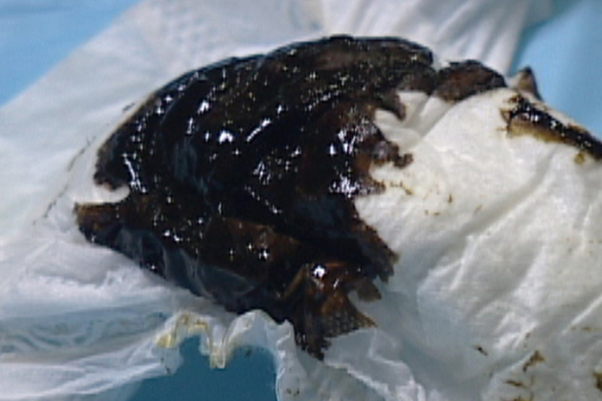- Poop that looks jagged or fuzzy might mean it’s time to load up your plate with fruits, vegetables, and whole grains.
- A low amount of fiber in your diet can result in poop that’s extremely soft.
Then, Why does my diarrhea look like dirt? These muddy hues are the result of mixing digested food with broken down bits of dead red blood cells that get dumped into the small intestine along with bile, an enzyme produced by the liver to digest fats.
What causes grainy stools in adults?
A common source of white specks in the stool is undigested food. Sometimes foods that are difficult to digest — like quinoa, nuts, seeds, high-fiber vegetables, and corn — can actually move through the digestive tract without fully digesting. This can cause small white flecks in the stool.
What causes Sandy diarrhea? You get it by drinking water or eating food that’s been contaminated by a person infected with the parasite. A person infected with cyclospora passes the parasite in stool. However, unlike some other foodborne parasites, cyclospora doesn’t become infectious until days or weeks after it’s passed in a bowel movement.
moreover Why is my poop Black and Sandy? Black or tarry stools with a foul smell are a sign of a problem in the upper digestive tract. It most often indicates that there is bleeding in the stomach, small intestine, or right side of the colon. The term melena is used to describe this finding.
What does stress poop look like?
Anxiety poop may also be linked to an underlying condition, Eid says. Warning signs to look out for include: blood in your stool. black, tar-colored stool.
What does ulcerative colitis poop look like?
Stool-related symptoms of ulcerative colitis include: diarrhea. bloody stools that may be bright red, pink, or tarry. urgent bowel movements.
What are the 4 types of diarrhea?
It can be divided into three basic categories: watery, fatty (malabsorption), and inflammatory. Watery diarrhea may be subdivided into osmotic, secretory, and functional types. Watery diarrhea includes irritable bowel syndrome, which is the most common cause of functional diarrhea.
What are the signs of internal bleeding?
These could be symptoms of internal bleeding: dizziness. severe weakness.
…
Internal bleeding in your chest or abdomen
- abdominal pain.
- shortness of breath.
- chest pain.
- dizziness, especially when standing.
- bruising around your navel or on the sides of your abdomen.
- nausea.
- vomiting.
- blood in urine.
How do you know if you have gastrointestinal bleeding?
Overt bleeding might show up as: Vomiting blood, which might be red or might be dark brown and resemble coffee grounds in texture. Black, tarry stool. Rectal bleeding, usually in or with stool.
Can you bleed internally without knowing it?
Intra-abdominal bleeding may be hidden and present only with pain, but if there is enough blood loss, the patient may complain of weakness, lightheadedness, shortness of breath, and other symptoms of shock and decreased blood pressure. Once again, the symptoms depend upon where in the abdomen the bleeding occurs.
What causes gastrointestinal bleeding?
There are many possible causes of GI bleeding, including hemorrhoids, peptic ulcers, tears or inflammation in the esophagus, diverticulosis and diverticulitis, ulcerative colitis and Crohn’s disease, colonic polyps, or cancer in the colon, stomach or esophagus.
Why is water not given to accident victims?
Another reason why giving water to Accident victims is bad is because it increases the person’s Blood pressure and when this happens, the wounds starts opening because the bloods would be pressured to pop out of the body. So, don’t give bleeding accident victims water to drink no matter how thirsty they are.
What does a GI bleed smell like?
Bleeding can be streaks of blood or larger clots. It can be mixed in with the stool or form a coating outside the stool. If the bleeding starts further up in the lower GI tract, your child may have black sticky stool called “melena”, which can sometimes look like tar and smell foul.
What medication can cause gastrointestinal bleeding?
Drugs that can lead to gastrointestinal bleeding include non-steroidal anti-inflammatory drugs (NSAIDs) like diclofenac and ibuprofen, platelet inhibitors such as acetylsalicylic acid (ASS), clopidogrel and prasugrel, as well as anticoagulants like vitamin-K antagonists, heparin or direct oral anticoagulants (DOAKs).
What blood in stool looks like?
When you have blood in your stool it can look a few different ways. You may have bright red streaks of blood on your poop or you could see blood mixed in with it. Stool could also look very dark, almost black, and tarry. Sometimes, you can have blood in your stool that’s not visible.
What does colitis poop look like?
Stool-related symptoms of ulcerative colitis include: diarrhea. bloody stools that may be bright red, pink, or tarry. urgent bowel movements.
Why is my poop grainy and yellow?
Carrots, sweet potatoes, turmeric, and foods that contain yellow food coloring may cause stool to become yellow. A diet high in fat or gluten can also lead to yellow stool. If a person regularly has yellow stools, they should try avoiding fatty, processed foods, gluten, or anything that causes an upset stomach.
What does malabsorption poop look like?
Fat malabsorption Fatty stools are greasy and runny and particularly smelly. They may be light-colored and float. Fat malabsorption also leads to the malabsorption of fat-soluble vitamins (A, D, E and K).

